| Abstract  The working principle of the variable frequency air conditioner and the application of fuzzy control technology in the inverter air conditioner are discussed in depth, and the structure of the hardware system and the design of the software system are analyzed. Key words  air conditioner frequency conversion fuzzy control hardware system software system | |
| The goal of air conditioning technology is to create a comfortable environment for people, but from an indoor environment, a constant temperature environment is not a standard environment for hygiene and comfort. Because in addition to temperature, there are many factors such as humidity and air flow rate that affect comfort. Conventional air conditioning systems mostly use a simple mechanical temperature control switch to set the control temperature, and the constant temperature control of the air conditioning system is achieved by stopping the compressor. On the one hand, this temperature-variable operation mode ignores the multi-factors that affect the comfort of the human body; on the other hand, due to the frequent starting and stopping of the compressor, not only the compressor is easily damaged, but also causes a certain energy loss. The variable-frequency air conditioner with fuzzy control can automatically adjust the speed of the compressor according to the thermal environment of the room, creating a comfortable environment for people, and also conducive to saving energy and prolonging the service life of the compressor. | |
| 1 Working principle of inverter air conditioner The inverter air conditioner adopts variable capacity refrigeration system consisting of inverter compressor, electronic expansion valve, indoor and outdoor heat exchanger and fan system. The system mainly completes three adjustment functions, namely: compressor power Adjustment, refrigerant flow regulation, and adjustment of heat exchanger capacity. The compressor power regulation is completed by the frequency converter, the refrigerant flow rate is regulated by the electronic expansion valve, and the heat exchange capacity is regulated by the fan. The inverter air conditioner adopts fuzzy control technology to process the input variables by fuzzy technology, which can realize dynamic control of multivariables. The control relationship is shown in Figure 1. It includes three input quantities: indoor temperature difference and its rate of change over time, the temperature of the wall of the indoor heat exchanger and its rate of change with time, the temperature of the wall of the outdoor heat exchanger and its rate of change with time. The output includes intelligent control of functions such as cooling, heating, dehumidification, defrosting, wind direction, and air volume of the air conditioner. | |
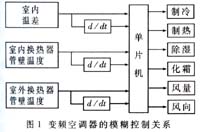 | 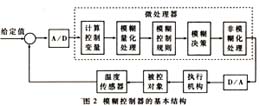 |
| The working principle of the inverter air conditioner can be seen in Figure 2. It can be divided into three parts: fuzzy input interface, fuzzy inference decision making mechanism and fuzzy output interface. | |
| The main function of the fuzzy input interface is to calculate the input variable of the selected system according to the system output value obtained by this sampling, and change the exact value of the input variable into a fuzzy quantity, that is, the temperature difference of the controlled system and the rate of change of the temperature difference are accurate. Values ​​are converted to fuzzy quantities for fuzzy reasoning and decision making. The main function of the fuzzy decision-making mechanism is to infer the control decision based on the fuzzy quantity of the input variable and the fuzzy inference rule table. The main function of the fuzzy output interface is to convert the fuzzy control quantity obtained by the fuzzy inference decision into an accurate quantity to control the speed of the compressor. | |
| 2 Fuzzy control in the inverter air conditioner The controller of the inverter air conditioner in the automatic working mode, infers the operating frequency of the inverter according to the temperature difference and the temperature difference change rate, and then controls the running speed of the compressor. | |
| 2.1 Accurate amount of fuzzification This system adopts the widely used two-dimensional fuzzy controller. Let the fuzzy variables be: eî—¤ temperature difference î—¥, de / dt î—¤ temperature difference change rate î—¥, f î—¤ output î—¥ î—¥. The corresponding fuzzy language variable takes the following values: e=负大(NB)î–„è´Ÿå°(NS)零(ZO)î–„æ£å°(PS), æ£å¤§(PB)  â–³e=高高(NH)低低(NL)零(ZO)î–„æ£æ£ä½Ž(PL)î–„æ£é«˜(PH) f =  zero (ZO) î–„ low (L) î–„ medium (M) î–„ high (H) î–„ highest (MH)  The precise amount of fuzzification is mainly to obtain the membership function of each word set. 2.2.1 The membership function of the temperature difference fuzzy subset can divide the temperature difference domain into 7 files -3, -2, -1, 0, 1, 2, 3 , and the statistical table of fuzzy variables e can be obtained through statistics, such as Table 1 shows. | |
 | |
| 2.2.2 Temperature change rate The membership function of the fuzzy subset sets the temperature difference change rate into 7 files -3, -2, -1, 0, 1, 2, 3 . The fuzzy variable de/dt can be obtained through statistics. The assignment table is shown in Table 2. | |
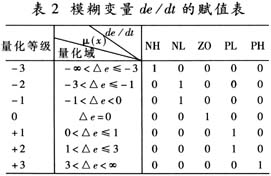 | |
| 2.2.3 Output quantity Fuzzy sub-set membership function Set the output quantity quantization domain into 7 files 0,1,2,3,4,5,6, and the evaluation table of the output variable f can be obtained through statistics. Shown. | |
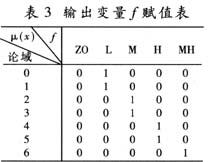 | |
2.2 Formation of Fuzzy Control Rules For a two-input single-output fuzzy controller, the control rules can be written as follows: IF e=Ai and de/dt=Bj then f=Cij i=1 2...nj=1 2...m Among them Ai: temperature difference e fuzzy subset, Bj temperature difference change rate de/dt fuzzy subset, Cij output f fuzzy subset. According to the actual operation experience, the fuzzy control rules can be determined as shown in Table 4. | |
 | |
2.3 Fuzzy Inference The control rules in Table 4 can be expressed as a total fuzzy relation R, that is, the membership function of R is     When the input fuzzy variables respectively take the fuzzy sets Ai, Bj, the output Cij can be obtained according to the fuzzy inference synthesis rule. Cij= AiXBj oR Then the membership function of the output C is  After obtaining the membership function of the output according to the above formula, using the weighted average method, the final precise amount of the system 3 Inverter Air Conditioner Hardware System The new variable frequency fuzzy control air conditioner is actually a multi-CPU control system, as shown in Figure 3 and Figure 4. | |
 | |
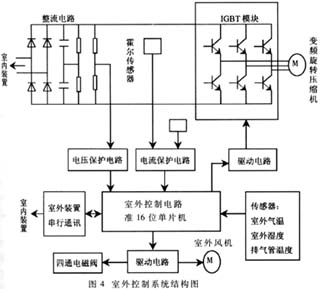 | |
| It mainly includes three parts: infrared remote control launching system, indoor unit control system, and outdoor unit control system. The infrared remote control launching system is a good human-computer interaction system, which is convenient for the user to select the corresponding air conditioner working mode and working parameters to control the opening and stopping of the air conditioner; the indoor unit control system receives the remote control command from the launching system, and by means of the transmission Sense technology, using fuzzy logic reasoning to automatically set the fan speed and compressor operating frequency, control the stepless speed regulation of the indoor fan and the swaying action of the damper, and transmit relevant decision information to the outdoor unit through serial communication; outdoor The unit control system receives the serial command of the indoor unit and uses the PWM pulse width modulation technology to continuously adjust the cooling capacity of the compressor. The three are independent of each other, and can effectively transmit and exchange information, and finally become an organic whole, so that it can achieve the desired results of convenient operation, reliable work, stable technical performance and high cost performance. | |
| 4 Software system design The software design of the variable frequency fuzzy control split air conditioner is divided into three parts: indoor unit, outdoor unit and remote control. The control command is transmitted between the indoor unit and the remote controller through infrared signal coding, and information is transmitted between the indoor unit and the outdoor unit by a serial communication interface. The indoor unit is the core of the control system, and its software control system consists of a main program and several subroutines. The subroutine consists of three levels. The highest level includes the cooling subroutine, the dehumidification subroutine, the fast/super static subroutine, and the emergency control subroutine; the intermediate level has the fan speed control subroutine, the damper stepper motor control subroutine, and the infrared remote command input. Capture interrupt service subroutine, real-time clock interrupt service subroutine, IRQ external interrupt service subroutine; lowest level serial communication subroutine, data acquisition and filtering subroutine, delay subroutine, alarm prompt subroutine, fuzzy inference engine, etc. . The main program flow chart is shown in Figure 5. | |
 | 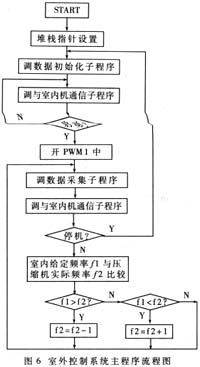 |
| The outdoor unit control system software can be divided into compressor frequency conversion control module, communication module with indoor unit and signal acquisition and control output. The inverter control software is the core of the outdoor unit control system. The main program flow chart is shown in Figure 6. Inverter air conditioners use fuzzy control technology to automatically adopt the best operation mode according to the surrounding environment to achieve the most comfortable environment. It has strong anti-interference ability, low cost, power saving and strong competitiveness. | |
:
Fiber Optical Distribution Box(Plastic)
Fiber Optic Distribution Box / Fiber Splitter Box is used as a termination point for the feeder cable to connect with drop cable. The fiber splicing, splitting, distribution can be done in this box, and meanwhile it provides solid protection and management for the FTTX network building.
Material: PC+ABS,wet-proof, water-proof, dust-proof, anti-aging, protection grade is IP65.Small Volume, For Indoor/Outdoor application. Compact structure,convenient installation and maintenance.
Fiber Optical Distribution Box (Plastic)
Fiber Optical Distribution Box,Plastic Fiber Optical Distribution Box,Fiber Optic Distribution Box,Optical Distribution Boxes
Sijee Optical Communication Technology Co.,Ltd , http://www.sijee-optical.com